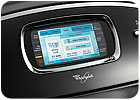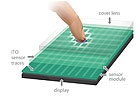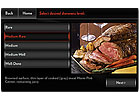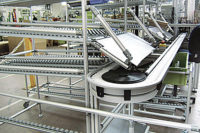
Traditionally, consumers use mechanical buttons, knobs, dials, sliders and switches to adjust time, temperature and other settings on household appliances. However, engineers have been experimenting with a wide variety of touch-sensitive interface technologies that make appliances easier to use and more aesthetically pleasing to look at.
The new displays and controls found in refrigerators, dishwashers, ovens, microwaves, coffee makers, washing machines and other products are inspired by the consumer electronics industry. Many consumers, especially those under 50 years old, have become accustomed to using touch screens on handheld devices, such as iPhones, iPods and iPads, in addition to ATMs, airport check-in kiosks, vending machines and other products.
“Touch screens are becoming widespread due to the ease of use and intuitive interfaces they enable, which can save time and increase productivity,” says Jennifer Colegrove, Ph.D., director of display technologies at DisplaySearch, a market research firm. “Falling prices have also spurred adoption. Finally, touch screen devices are now perceived as cool and fun.
“Touch screen penetration has been rapidly increasing in mobile phones, portable navigation devices, gaming and other applications,” adds Colegrove. She says the touch screen module market is growing 14 percent annually and will be a $9 billion industry by 2015, more than twice the size of today.
“In the future, people will think of refrigerators and other household appliances more as an electronic device rather than a mechanical device,” predicts Mike Deneen, appliance industry analyst at the Freedonia Group Inc. “During the next decade, we’ll see more consumer electronics manufacturers, such as LG, Panasonic, Samsung and Sharp, become more active in the appliance market, especially in the United States.”

Capacitive sensing technology uses resistive sensors and membranes switches.
Digital Convergence
Deneen believes that consumers will become more used to the omnipresence of digital devices in daily life. The same convergence that’s transformed automobiles and consumer electronics over the past decade will occur in household appliances during the next 10 years.
“Incremental cost is the main factor holding back full touch displays from widespread domestic appliance use,” says Ian Crosby, director of sales and marketing at Zytronic Displays Ltd., which makes interactive touch sensor products that are based on projected capacitive technology. “Mechanical switches are cheap compared to durable full-touch displays.” The additional cost of a touch screen can be anywhere from $8 to $20, which cannot be justified in lower-end appliances.
“However, the deployment of touch screens into all facets of life is inexorable, as the interfaces can be intuitive and compelling to use,” claims Crosby. “As with so many innovations, it is likely that they will initially be designed into higher-end appliances, whose purchasers will bear the incremental cost in the interests of having the latest and greatest product, and then progressively into more mainstream units as costs fall and general consumer demand grows.”
Touch screens enable capabilities that are not possible otherwise in appliances, such as the consolidation of multiple separate controls into a menu- or graphically driven interface. When all buttons are eliminated, the touch screen becomes the sole interface. A touch-based interface also enables higher-end features, such as digital photo display and Internet access.
“Displays and touch controls are being embraced by appliance makers as a way to differentiate their products from competitors,” says Jason dePreaux, a research analyst at IMS Research Ltd. “[They] have become more enticing as component costs have come down and [appliance engineers] become more familiar designing such systems in-house.”
As the appliance industry becomes more competitive, product innovation will play a more important role. While price and energy efficiency will remain strong purchase incentives, new features, such as touch technology, will become more critical.
“People want the products they buy to provide performance and aesthetical appeal in equal measure,” says Henrik Otto, senior vice president for design at Electrolux. “Performance could be seen as a prerequisite, with the design of a product acting as a differentiator.”
“Nine percent of consumers say that, aside from price, the latest technology and features are important for them when it comes to purchasing major household appliances,” adds Marc Blitzer, president of Whirlpool North America. He claims the industry is responding “with options that give consumers unparalleled control and style.”
Electrolux and Whirlpool both recently unveiled products that feature advanced interface technology. For instance, Electrolux’s air-o-steam Touchline professional oven boasts a high-definition touch screen that was developed with Hitachi. It features 262,000 colors, 30 different languages, and internationally recognized icons and food images. Cooking cycles, temperature and time are clearly visible, even at extreme visual angles.
Earlier this year, Whirlpool launched its Vantage washer-dryer, which features an intuitive LCD touch screen to deliver “an enhanced laundry experience.” The appliance giant also unveiled a Jenn-Air wall oven with a 7-inch glass touch screen that uses an image-enabled cooking guide.
“These aren’t your grandmother’s appliances,” claims Blitzer. “We’ve pushed ourselves to take a look at the best consumer electronics features on the market today and meld them [with appliances].”
“In today’s competitive home appliance market, manufacturers must add product differentiation at minimal cost to attract buyers and subsequently increase market share,” says John Sakamoto, senior director of the applications business unit at Altera Corp., which makes programmable logic devices (PLDs) that control appliance functions, such as display panels, temperature sensors and motors. “Typically, a new technology begins by being added to the top tier of products, migrates down to the midrange products, and eventually becomes a standard feature in almost all products.”
According to Sakamoto, future appliances will require more advanced display technology to facilitate the human-machine interaction. “Touch-screen displays enable OEMs to produce modern, sleek appliance controls, setting themselves apart from other brands and meeting current consumer expectations,” he points out.
“Using digital display technology in place of mechanical human-machine interfaces (HMIs) ultimately leads to more rapid development, increased reuse of componentized architectures, and, over the long term, more economical designs due to advancements in graphical user interface software and PLD technology,” adds Sakamoto. “Touch-screen displays on home appliances are a natural evolution from today’s consumer devices and the continuing drive of the ‘digital lifestyle’ market trend.”
“Incremental cost is the main factor holding back full touch displays from widespread domestic appliance use,” says Ian Crosby, director of sales and marketing at Zytronic Displays Ltd., which makes interactive touch sensor products that are based on projected capacitive technology. “Mechanical switches are cheap compared to durable full-touch displays.” The additional cost of a touch screen can be anywhere from $8 to $20, which cannot be justified in lower-end appliances.
“However, the deployment of touch screens into all facets of life is inexorable, as the interfaces can be intuitive and compelling to use,” claims Crosby. “As with so many innovations, it is likely that they will initially be designed into higher-end appliances, whose purchasers will bear the incremental cost in the interests of having the latest and greatest product, and then progressively into more mainstream units as costs fall and general consumer demand grows.”
Touch screens enable capabilities that are not possible otherwise in appliances, such as the consolidation of multiple separate controls into a menu- or graphically driven interface. When all buttons are eliminated, the touch screen becomes the sole interface. A touch-based interface also enables higher-end features, such as digital photo display and Internet access.
“Displays and touch controls are being embraced by appliance makers as a way to differentiate their products from competitors,” says Jason dePreaux, a research analyst at IMS Research Ltd. “[They] have become more enticing as component costs have come down and [appliance engineers] become more familiar designing such systems in-house.”
As the appliance industry becomes more competitive, product innovation will play a more important role. While price and energy efficiency will remain strong purchase incentives, new features, such as touch technology, will become more critical.
“People want the products they buy to provide performance and aesthetical appeal in equal measure,” says Henrik Otto, senior vice president for design at Electrolux. “Performance could be seen as a prerequisite, with the design of a product acting as a differentiator.”
“Nine percent of consumers say that, aside from price, the latest technology and features are important for them when it comes to purchasing major household appliances,” adds Marc Blitzer, president of Whirlpool North America. He claims the industry is responding “with options that give consumers unparalleled control and style.”
Electrolux and Whirlpool both recently unveiled products that feature advanced interface technology. For instance, Electrolux’s air-o-steam Touchline professional oven boasts a high-definition touch screen that was developed with Hitachi. It features 262,000 colors, 30 different languages, and internationally recognized icons and food images. Cooking cycles, temperature and time are clearly visible, even at extreme visual angles.
Earlier this year, Whirlpool launched its Vantage washer-dryer, which features an intuitive LCD touch screen to deliver “an enhanced laundry experience.” The appliance giant also unveiled a Jenn-Air wall oven with a 7-inch glass touch screen that uses an image-enabled cooking guide.
“These aren’t your grandmother’s appliances,” claims Blitzer. “We’ve pushed ourselves to take a look at the best consumer electronics features on the market today and meld them [with appliances].”
“In today’s competitive home appliance market, manufacturers must add product differentiation at minimal cost to attract buyers and subsequently increase market share,” says John Sakamoto, senior director of the applications business unit at Altera Corp., which makes programmable logic devices (PLDs) that control appliance functions, such as display panels, temperature sensors and motors. “Typically, a new technology begins by being added to the top tier of products, migrates down to the midrange products, and eventually becomes a standard feature in almost all products.”
According to Sakamoto, future appliances will require more advanced display technology to facilitate the human-machine interaction. “Touch-screen displays enable OEMs to produce modern, sleek appliance controls, setting themselves apart from other brands and meeting current consumer expectations,” he points out.
“Using digital display technology in place of mechanical human-machine interfaces (HMIs) ultimately leads to more rapid development, increased reuse of componentized architectures, and, over the long term, more economical designs due to advancements in graphical user interface software and PLD technology,” adds Sakamoto. “Touch-screen displays on home appliances are a natural evolution from today’s consumer devices and the continuing drive of the ‘digital lifestyle’ market trend.”

Ovens equipped with touch screens feature image-enabled cooking guides.
Diverse Options
The touch screen industry is diverse, with many companies pursuing several types of technologies. “There are over a dozen touch screen technologies,” says Colegrove. “Resistive touch screen technology is the leader in terms of unit shipments and more than 60 companies are manufacturing it. However, both surface and projected capacitive technologies have attracted numerous suppliers, and many companies are also pursuing multi-touch capabilities.”When looking at different technologies, it’s important to first decide how to define “touch,” as opposed to “press.” A true touch control would require only a touch, with no deflection of the overlay.
There are, however, technologies that require a very slight deflection of the overlay and slight application of force, just barely more than a touch, but still technically a press. For example, a cheap membrane switch on a microwave oven requires a press. But, appliance engineers can design these so that they only need a very slight press. It’s also possible to use a glossy polycarbonate overlay that emulates glass and create a simulated touch control that is really a cheap membrane switch.
For true touch screens, where no deflection force is required, appliance engineers must consider capacitive, inductive, acoustic or infrared technologies. Each has its pluses and minuses. Issues include cost, complexity, optical clarity of the touch screen, accuracy in determining exact location of the touch, and safety issues regarding false actuation.
Resistive touch screens rely on a thin film or membrane that is applied to the touch surface. Tiny wires embedded in the display overlay detect touch by virtue of the pressure changing the resistance. The technology is relatively inexpensive, but it’s also fragile. The surface film degrades over time and limits the optical clarity of the display in high-use environments.
Capacitive touch screens are generally more robust than resistive products. However, they are expensive to manufacture. Capacitive technologies require finger contact and often suffer from false touches.
Surface acoustic wave and infrared devices use surface-mounted components that project either an acoustic wave or an infrared beam across the touchscreen area. However, the technology is more expensive than resistive and capacitive systems. In addition, dust and condensation can create blind spots.
The majority of home appliances currently featuring touch controls use capacitive technology with glass overlay. Capacitive interfaces are stationary, so they do not wear out. They are also closed to the environment, so they stay clean and are not susceptible to environmental contamination. In addition, capacitive interfaces are much more flexible than mechanical interfaces.
“A single capacitive touch controller can be used to implement touch buttons, linear or radial sliders, a proximity sensor or a touch screen,” says Steve Berry, director of touch technologies at Atmel Corp., which markets a family of products called maXTouch and QTouch. “Touch interfaces can provide all this flexibility and robustness without compromising performance or reliability.”
Next month, Atmel will start releasing touch systems designed specifically for the appliance industry. “These devices will include additional self-test algorithms that ensure the device is working correctly and prevent compromised safety conditions,” Berry points out. “These features are compliant with the global safety and failure modes effects analysis (FMEA) standard for the appliance industry, EN60730.”
“Capacitive interfaces allow for a seamless interface, are easy to clean, and feature less quality variation than is found in the conventional ‘dome switch under a laminate cover’ that is used in most microwaves,” claims Victor Viegas, CEO of Immersion Corp., which has developed a line of tactile feedback systems called TouchSense. “Capacitive interfaces also allow for the flexibility of having dynamic graphics, such as a screen behind capacitive glass, or fixed images, such as printed labels.
“Since the capacitive sensing is on the rear of the surface, the labels and sensors never wear out, unlike many systems today,” adds Viegas. “Capacitive sensing input has a lifetime operation that is literally infinite.” A

